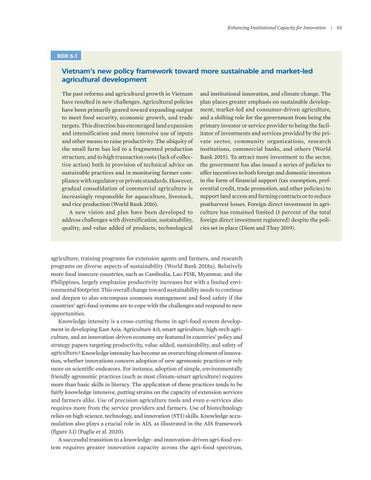Enhancing Institutional Capacity for Innovation | 83
BOX 6.1
Vietnam’s new policy framework toward more sustainable and market-led agricultural development The past reforms and agricultural growth in Vietnam have resulted in new challenges. Agricultural policies have been primarily geared toward expanding output to meet food security, economic growth, and trade targets. This direction has encouraged land expansion and intensification and more intensive use of inputs and other means to raise productivity. The ubiquity of the small farm has led to a fragmented production structure, and to high transaction costs (lack of collective action) both in provision of technical advice on sustainable practices and in monitoring farmer compliance with regulatory or private standards. However, gradual consolidation of commercial agriculture is increasingly responsible for aquaculture, livestock, and rice production (World Bank 2016). A new vision and plan have been developed to address challenges with diversification, sustainability, quality, and value added of products, technological
and institutional innovation, and climate change. The plan places greater emphasis on sustainable development, market-led and consumer-driven agriculture, and a shifting role for the government from being the primary investor or service provider to being the facilitator of investments and services provided by the private sector, community organizations, research institutions, commercial banks, and others (World Bank 2015). To attract more investment to the sector, the government has also issued a series of policies to offer incentives to both foreign and domestic investors in the form of financial support (tax exemption, preferential credit, trade promotion, and other policies) to support land access and farming contracts or to reduce postharvest losses. Foreign direct investment in agriculture has remained limited (1 percent of the total foreign direct investment registered) despite the policies set in place (Diem and Thuy 2019).
agriculture, training programs for extension agents and farmers, and research programs on diverse aspects of sustainability (World Bank 2018a). Relatively more food insecure countries, such as Cambodia, Lao PDR, Myanmar, and the Philippines, largely emphasize productivity increases but with a limited environmental footprint. This overall change toward sustainability needs to continue and deepen to also encompass zoonoses management and food safety if the countries’ agri-food systems are to cope with the challenges and respond to new opportunities. Knowledge intensity is a cross-cutting theme in agri-food system development in developing East Asia. Agriculture 4.0, smart agriculture, high-tech agriculture, and an innovation-driven economy are featured in countries’ policy and strategy papers targeting productivity, value added, sustainability, and safety of agriculture.4 Knowledge intensity has become an overarching element of innovation, whether innovations concern adoption of new agronomic practices or rely more on scientific endeavors. For instance, adoption of simple, environmentally friendly agronomic practices (such as most climate-smart agriculture) requires more than basic skills in literacy. The application of these practices tends to be fairly knowledge intensive, putting strains on the capacity of extension services and farmers alike. Use of precision agriculture tools and even e-services also requires more from the service providers and farmers. Use of biotechnology relies on high science, technology, and innovation (STI) skills. Knowledge accumulation also plays a crucial role in AIS, as illustrated in the AIS framework (figure 3.1) (Fuglie et al. 2020). A successful transition to a knowledge- and innovation-driven agri-food system requires greater innovation capacity across the agri-food spectrum,

